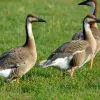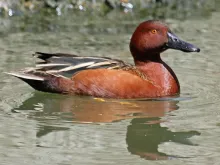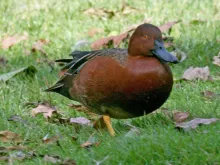
Cinnamon Teal (Anas cyanoptera)
Species name
- Dutch name:
- Kaneeltaling
- English name:
- Cinnamon Teal
- German name:
- Zimtente
- French name:
- Sarcelle cannelle
- Scientific name:
- Anas cyanoptera
Scientific classification
- Order:
- Anseriformes
- Family:
- Anatidae
- Onderfamilie:
- Anatinae
- Genus:
- Anas
Description
- Description:
Male:
Head, neck, Breast, sides, flanks and underparts bright rusty–chestnut. Darker brown-black, rump and uppertail and under tail converts. Long, black scapulars with prominent buff cream with blue stripes trail over flanks of resting bird. Tail blackish with rusty edges. Wings dark brown flight feathers and bright blue forewing separated from green speculum by solid white band; underwing dark, with whitish central stripe. Bill black. Legs and feet orange yellow. Eyes yellow, orange to vibrant red.Female:
Heavily streaked blackish on head and chin, on a Tanish brown face. Some have a faint black eye stripe. Some Darker than others. Marbling down sides and upperparts feathers blackish centers edged with buff tan. Rusty brown on underparts. Wings dark brown flight feathers and bright blue forewing separated from green speculum by a white bar with speckled with bluish-brown spots on each secondary feather; underwing dark. Bill Dark grey with some having yellowish coloring by base of the top mandible and spotted black.Juvenile:
More heavily streaked on underparts and less Rufous over-all. chestnut tones start to appear from October–November. Soon as the Young grow out there wing feathers at 8 to 10 weeks you can identify the sexes: Male has bright blue forewing separated from green speculum by solid white band. And iris starts to turn color orangeish red in October. Female: bright blue forewing separated from green speculum by a white bar with speckled with bluish-brown spots on each secondary feather.
Standard Measurements
- Body Length (cm):
- The male (drake) of the Cinnamon Teal measures approximately 35-48 centimeters. The female measures approximately 35-48 centimeters.
- Body Weight (grams):
- The male will weight about 410-540 gram. The female will weight about 360-500 gram.
The weight is notoriously variable and can only be used as indication!
- Subspecies:
There are 5 subspecies:
- Northern cinnamon teal - Spatula cyanoptera septentrionalium
- Argentine cinnamon teal - Spatula cyanoptera cyanoptera
- Andean cinnamon teal - Spatula cyanoptera orinoma
- Tropical cinnamon teal - Spatula cyanoptera tropica
- Borrero's cinnamon teal - Spatula cyanoptera borreroi
- Note:
Dabbling Ducks are generally hardy, easy to maintain and easy to breed. Shelter may be required by some of the smaller species in winter. They should be provided with cover (including marginal pond cover) and loafing areas as well as water. A pen which is 50% water is suggested. The water may be shallow (i.e. no more than two feet deep is required), and muddy areas for dabbling in are also appreciated. These ducks are generally good in mixed collections, although the smaller and quieter species may be bullied. Territorial disputes between ducks of the same species may be avoided by keeping only one pair of each species in an enclosure, unless the area is very large. For a single pair of ducks a pen are of 50 to 100 square metres, depending on the size of duck, should be provided.
A diet based on wheat and pellets is suggested, with maintenance pellets changed to breeders pellets for the breeding season. Bread and greenfood are also appreciated. Grit should always be available, with soluble grit (e.g. oystershell grit) as a calcium source when breeding.
Most species are ground nesters and both close ground cover and ground level nest boxes should be provided. Hand-rearing is generally preferred, as these ducks are generally poor parents in captive conditions, particularly in enclosures shared with other waterfowl. These ducks are prone to hybridization, particularly with closely related species, which should be kept apart from one another.
Cinnamon teal are reasonably hardy but protection from frost suggested. Quiet, and suitable for mixed collections with other small ducks, they may be aggressive while nesting. Shallow, muddy water and good marginal pond vegetation should be provided. Feed as other dabbling ducks, with extra animal material while breeding and rearing.
These ducks breed fairly readily. Good natural cover such as long grass near water is desirable for nesting, but they may occasionally use ground-level nest boxes or baskets. May lay in April to July. Broody or artificial hatching and rearing of the delicate ducklings is suggested, with good protection from wet and cold. Chopped green food and mealworms should be added to starter crumbs to encourage feeding initially.
Readily hybridise with Blue-winged teal (Anas discors); should not be kept in same enclosure!
Hybrids also reported with Red shoveler (Anas platalea), Mallard (Anas platyrhynchos), Northern shoveler (Anas clypeata), Speckled teal (Anas flavirostris), Garganey (Anas querquedula), Wood duck (Aix sponsa).
- Breeding:
- The female Cinnamon Teal usually lays from 9-12 white, pale cream or buff-pink eggs and incubates them for 21-25 days.
- Artificial incubating:
The ideal relative humidity for incubating most waterfowl eggs is 55% (ground nesters) and 40% (cavity nesters). The temperature is usually 37.4°C. Set ventilation as recommended by the incubator manufacturer. Eggs must be turned, either automatically or by hand, a minimum of 4 times a day. As the duckling develops there is a loss of water from the egg and the air sac gets bigger. In normal development of an egg with a 21-25 days incubation, the air sac occupies about a third of it three days earlier. Cleanliness is vital and ideally eggs should be moved to a separate hatcher at this point, where the humidity should be increased to 65% and even higher once they have pipped internally.
- Bird banding:
- Recommended closed leg band ring size for the Cinnamon Teal is 8 mm.The leg band ring can only be applied on a young dabbling duck at around 10-11 days old.
- It doesn't matter what leg that you band, but it's good to have a consistent system. Suggested: Left leg = Female, Right leg = Male
- Maintenance food:
-





Lundi Regular with a protein content of 20%, valuable Spirulina and high-quality by-products is optimally balanced in its composition maintenance food for water ornamental fowl of all kinds. Especially green teal and Whistling ducks that are not dependent on a very high protein content, are well supplied.
Lundi Regular contains all the minerals and vitamins in full form that are important for the animals. Therefore also suitable as breeding food.


